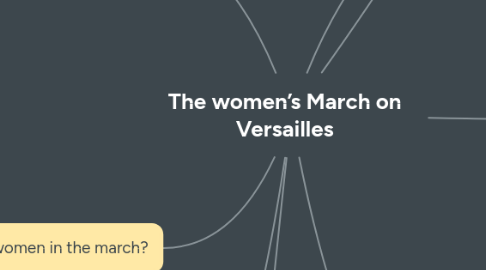
1. Was also known as the October march, The march on Versailles etc.
1.1. Was one of the most significant and early events of the French Revolution.
2. Began among women in market places of Paris.
2.1. On the morning of October 5, 1789, the women were near rioting over the high price and scarcity of bread.
3. Their demonstrations quickly merged with the activities of the revolutionaries.
3.1. The market women and their various allies and comrades grew in number which finally became in thousands.
3.2. The revolutionaries were seeking liberal, political reforms for France.
3.2.1. Then the people encouraged by revolutionary agitators, raided the city armoury for weapons and then marched to the palace of Versailles.
3.2.1.1. The crowd besieged the palace and in a dramatic and violent confrontation. And successfully pressed upon their demands upon their king.
3.2.1.2. The revolutionaries suggested this as there they could certainly confront king Louis 16. They called him the “baker” and his wife “baker’s wife”
4. Were there only women in the march?
4.1. Although it is called as the women’s march but there were also men present in the crowd.
4.1.1. One of the main leaders was a man named Stanislas-Marie Maillard.
4.1.2. After they entered the palace a small group of women went to meet the king. He agreed to provide them food from the King’s stores and promised more in the future.
5. At the palace.
5.1. After six hours in the pouring rain when their demands were finally fulfilled, a small group seemed to leave, though many stayed and continued to protest.
5.1.1. Early next morning some people were able to enter the palace and thus fighting broke out, some guards were also killed.
5.1.1.1. Eventually peace was restored by Marquis de Lafayette, the leader of the national guard
6. Problem with royalty.
6.1. Later that day the king addressed the crowd.
6.1.1. The revolutionaries demanded that he return with them to Paris. He agreed.
6.2. The crowd also demanded to see Marie Antoinette, the queen.
6.2.1. The people blamed a lot of their problems on her and her lavish spending habits.
6.2.2. The queen agreed and appeared on the balcony with her children, but the crowd demanded the children to be taken away.
6.2.2.1. She stood there by herself with many in the crowd pointing guns at her. She may have been killed, but Lafayette knelt before her and kissed her hand. The crowd calmed down and allowed her to live.
7. The King’s return
7.1. The royal family travelled back to Paris when the crowd, by this time the crowd had grown from 7,000 marchers to 60,000 marchers.
7.1.1. After returning, the king went to live at Tuileries palace in Paris. He never saw or returned to the palace of Versailles.
